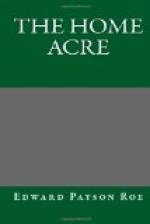In the limited area of an acre there is usually not very much range in soil and locality. The owner must make the best of what he has bought, and remedy unfavorable conditions, if they exist, by skill. It should be remembered that peaty, cold, damp, spongy soils are unfit for fruit-trees of any kind. We can scarcely imagine, however, that one would buy land for a home containing much soil of this nature. A sandy loam, with a subsoil that dries out so quickly that it can be worked after a heavy rain, is the best for nearly all the fruit-trees, especially for cherries and peaches. Therefore in selecting the ground, be sure it is well drained.
If the acre has been enriched and plowed twice deeply, as I have already suggested, little more is necessary in planting than to excavate a hole large enough to receive the roots spread out in their natural positions. Should no such thorough and general preparation have been made, or if the ground is hard, poor, and stony, the owner will find it to his advantage to dig a good-sized hole three or four feet across and two deep, filling in and around the tree with fine rich surface soil. If he can obtain some thoroughly decomposed compost or manure, for instance, as the scrapings of a barnyard, or rich black soil from an old pasture, to mix with the earth beneath and around the roots, the good effects will be seen speedily; but in no instance should raw manure from the stable, or anything that must decay before becoming plant food, be brought in contact with the roots. Again I repeat my caution against planting too deeply—one of the commonest and most fatal errors. Let the tree be set about




